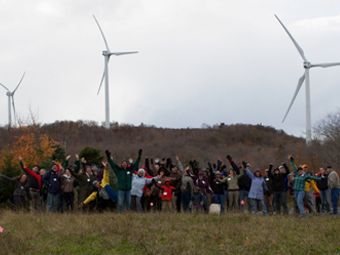A proposed three-year moratorium on renewable wind energy development in Vermont was roundly criticized today by some of Vermont’s leading environmental organizations. Groups including the Vermont Public Interest Research Group, Conservation Law Foundation, 350Vermont, Sierra Club Vermont Chapter, Vermont Natural Resources Council, Citizens Awareness Network, National Wildlife Federation’s Northeast Regional Center, and the Vermont Yankee Decommissioning Alliance all came out strongly against a moratorium bill introduced by state senators Joe Benning and Bob Hartwell.
“With storms like Irene and Sandy still fresh in our minds, and 2012 having broken all sorts of records for heat, droughts and floods, this is no time to retreat from Vermont’s commitment to clean energy,” said Paul Burns, executive director of VPIRG.
From an environmental standpoint, the groups pointed out that it would be irresponsible to simply ask others outside of Vermont to bear the burden of producing power for our energy needs. And, it’s always more efficient to generate power as close as possible to where it is used.
“Buying power from outside Vermont means we are exporting air and water pollution and environmental damage by continuing our reliance on large scale hydro-dams, dirty coal and oil, and nuclear power,” said Christopher Kilian, Vermont Director for Conservation Law Foundation. “These energy sources are extremely damaging from both an environmental and public health perspective; wind and other renewable energy produced in Vermont is a key part of the transition away from these dirty sources of electricity.”
More than a year ago, the state adopted a plan calling for 90 percent of its energy needs to be met with renewable resources by 2050. This plan is one of the most ambitious in the nation, and was the result of many months of work and a great deal of public input.
Numerous public opinion surveys have confirmed that a huge majority of Vermont residents support the development of local renewable energy resources. For instance, a poll released by WCAX TV last May found that nearly 70 percent of Vermonters support ridgeline wind development while just 17 percent oppose wind energy.
“There will always be those who oppose clean energy, be it wind, solar or backyard clothes lines. But we must not allow the extreme voices of those who refuse to take responsibility for our energy future to dictate our legacy,” said Kilian. “We can do better than that.”
“Climate change is our most critical environmental challenge. To avoid the impacts of severe climate change on our environment and infrastructure, the atmosphere’s carbon content must be reduced to a sustainable level as soon as possible. And because the residence time of carbon in our atmosphere is so long, reducing our carbon emissions becomes an urgent task,” said Charles McKenna, Executive Committee Member, Sierra Club Vermont Chapter and Upper Valley Group.
The proposed legislation comes as a state Energy Siting Commission is considering various proposals for improving the way energy generating projects are regulated and approved by the state. Recommendations by the Commission are due to be completed by April 30, 2013.
“The independent commission is hearing from virtually all interested parties at this point,” said Brian Shupe, executive director of VNRC. “We ought to give them a chance to do their job, which is scheduled to be completed by this April, and provide a comprehensive set of recommendations for improving how all energy facilities are sited in Vermont.”
With two new wind projects coming online in the closing days of 2012, grid-scale wind turbines now produce enough energy in Vermont to power more than 45,000 households. That’s a significant percentage of the state’s overall energy needs, but advocates point out that there’s the potential to tap even more wind energy in the state.
“Carefully sited wind is an important part of the solution, but it’s just one part of a responsible energy mix,” said VNRC’s Shupe. “We need to do more to maximize energy efficiency and conservation, and of course we need a diversified portfolio of renewable energy sources in order to meet the state’s ambitious energy goal.”
“We are in the process of creating a paradigm shift in the way we generate energy,” said Deb Katz, executive director of Citizens Awareness Network. “This shift requires a commitment to a sustainable energy future; we cannot allow fear or doubt to weaken our resolve.”
“NWF has long supported efforts to increase clean energy to address our climate crisis. On the heels of news that Vermonters and wildlife living around Burlington just experienced the hottest year on record in 2012, we find an effort to single out wind development for a 3 year moratorium as very suspect. We support the Governor’s effort to review Vermont’s siting process for all energy facilities through the creation of the Energy Siting Commission and we urge members of the Vermont Legislature to oppose the moratorium bill and work on policies which tackle our climate crisis, increase renewable energy, conservation and efficiency while ensuring wildlife protections through responsible siting,” said Curtis Fisher, Regional Executive Director, NWF Northeast Regional Center.
“The urgent need to reverse climate change is undeniable,” said Maeve McBride, organizer for 350Vermont. “Burlington’s average temperature for 2012 was 5 degrees above normal. Globally, 2012 saw unprecedented droughts, superstorms, and rapid reductions in ice cover. We need moratoriums on fossil fuels, not on renewables. Wind energy is an essential piece of Vermont’s energy future. Let’s proceed with care, but keep moving forward.”
“Putting a stop to renewable wind energy development in Vermont, as this legislation proposes, is not the solution to our energy needs. In fact, it’s part of the problem,” concluded VPIRG’s Burns.
Take action to oppose the wind moratorium here.
For more information about wind energy in Vermont, click here.

